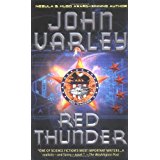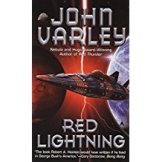



John Varley, Red Thunder. Ace Books, 2003, 411 pp. ISBN 0-441-01162-4
John Varley, Red Lightning. Ace Books, 2006, 351 pp. ISBN 978-0-441-01488-0
John Varley, Rolling Thunder. Ace Books, 2008, 376 pp. ISBN 978-0-441-01772-0
John Varley, Dark Lightning. Ace Books, 2014, 341 pp. ISBN 978-0-425-27408-8
Rating: 9 out of 10
John Varley has been one of my favorite SF authors for a long time. He’s not hugely productive: his website lists 13 novels and 6 short-story collections in a career spanning 40 years since the publication of his first novel, The Ophiuchi Hotline. His books have invariably been highly original, coming up with surprising concepts and gadgets every couple of pages. He also has a keen sense of humor and a penchant for composing phrases that stay with you for years. My favorite is the opening line of Steel Beach: “‘In five years, the penis will be obsolete’, said the salesman.” (Personally, I would have phrased this slightly different: “‘In five years’, the salesman said, ‘the penis will be obsolete’.” Judge for yourself which version you prefer…) Besides being a gifted author, Varley is an avid fan of Robert A. Heinlein, one of my favorite authors.
Varley’s Thunder and Lightning series consists of 4 novels and is an homage to Heinlein’s juvenile novels. In consequence, the main characters of each novel are all adolescents. The series is a feast of memories for any Heinlein enthusiast. Almost any personage bears the name of one of Heinlein’s most famous characters. The first novel in the series, Red Thunder, introduces us to Manny Garcia and his best friend Dak. Mannie is fascinated by space travel but has little hope of eventually becoming an astronaut, as his family is poor and he spends most of his time that he is not in school helping his family run a more or less dilapidated business, the Blast-Off Motel, close to Cape Canaveral. Early on, the friends meet a former astronaut, Travis Broussard, and his brilliant physicist cousin, Jubal. And on it goes. For example, the protagonist of the third novel, Rolling Thunder, is Manny’s granddaughter, Podkayne, and those of the fourth novel, Dark Lightning, are the twins, Cassie and Polly. Of course, there are many more and probably also some that I didn’t recognize because I read the relevant Heinlein novel too long ago. That is also the reason that I recently (re-)read all four volumes of this series. I had originally bought the first volumes when they appeared and read them at the time. For some reason I didn’t buy the fourth volume, Dark Lightning, when it came out in 2014 and only recently became aware of my omission. However, when the book arrived and I started reading it, I soon realized that I didn’t remember much more than rough outlines of the previous three novels, so I stopped reading and (re-)read the whole series in the space of a little bit more than a week. It was an exercise that I can heartily recommend!
In principle, the four books can be read independently, but in my experience the series makes much more sense when they are read in close proximity. The story is in the best traditions of the Golden Age and Heinlein’s proclivity for private initiative as opposed to (usually inept) government action is faithfully maintained. The action starts with a space race between China and the United States to be the first to land on Mars, which the US is losing. Badly, in fact, because the propulsion drives of their space ship blow up before Mars is even reached. Enter Manny and his friends, who, armed with a drive based on limitless energy (an invention of Jubal), build a spaceship on a shoestring budget of $1 million, using second-hand space suits and an old railroad tanker car. And although they start building only after the American and Chinese missions have already been launched and are well underway, the continuous propulsion that Jubal’s limitless energy source makes possible, allows them to arrive on Mars first, before the Chinese. Basically as an afterthought, they rescue the survivors of the US mission on their way home.
The second novel, Red Lightning is set a generation later on Mars, which has been colonized and where a now adult Manny owns a hotel, while his mother still manages her motel in Florida back on Earth. If you know Heinlein, you won’t be surprised that one of the subplots involves Earth trying to impose its will on the Martian colonists. The main plot concerns a disaster on Earth, which is struck by an unknown object, and Mannie and his family and friends travel to a Florida devastated by a huge tsunami to search for his mother. During all this, Mannie’s son Ray finds his soulmate and their daughter, Podkayne, is the protagonist of the third novel, Rolling Thunder. The fourth volume is set aboard a generation ship, named Rolling Thunder, and the protagonists are the twin daughters of Podkayne and Jubal, Cassie and Pollie.
I am not going to describe the plots in more detail, so as not to spoil the fun for anybody who has not yet read these books. Suffice to say that there are several original inventions that are vintage Varley. For example, Red Lightning (which starts with one of the shortest opening lines that I’ve ever seen: “Mars sucks”) starts with a vivid description of Ray Garcia-Strickland, Mannie’s son, riding his surf board down from Phobos to Thunder City (yep, there’s a pattern here…), something that is made possible by the low Martian gravity, the thin atmosphere, and Jubal’s limitless energy invention. This space surfing is something many adolescents do and is considered about as safe as ocean surfing in Florida. An added original touch is that many kids cover the underside of their “surf board” (more like an open miniature space craft) with chemicals that burn off during descent, leaving a brightly colored sparkling trail, kind of like a fire cracker.
According to a 2009 interview on Republibot, the fourth volume is the last one in the series, but to me it feels that the story isn’t finished yet. And I, for one, would love to learn how things develop further now that Jubal has invented a drive that permits immediate displacement over stellar distances!